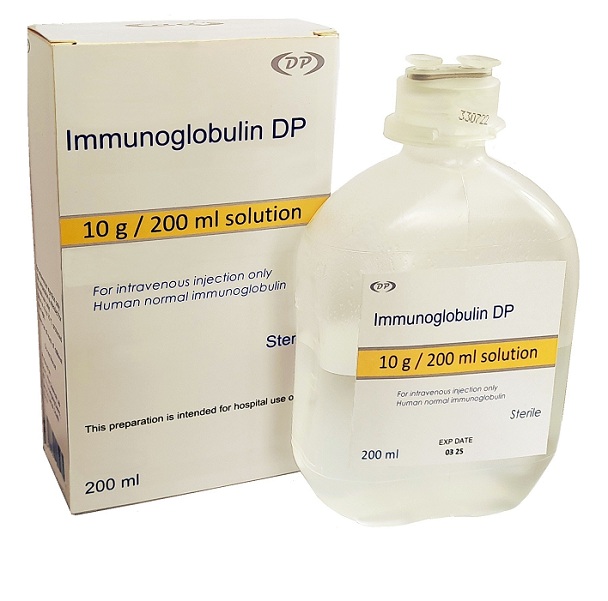Pharmacology
Increases the level of antibodies in the body. Bioavailability is 100% when given by IV infusion. There is redistribution between plasma and extravascular space, with equilibrium reached after about 7 days. Individuals with normal serum IgG have an average biological half-life of 21 days, while patients with primary hypo- or agammaglobulinemia have an average of 32 days. It contains a wide range of opsonizing and neutralizing antibodies against bacteria, viruses and other pathogens. In patients suffering from primary or secondary immunodeficiency syndromes, it provides replenishment of missing class IgG antibodies, which reduces the risk of infection.
Application of the Immunoglobulin DP
Replacement therapy for the prevention of infections in primary immunodeficiency syndromes: agammaglobulinemia, common variable immunodeficiencies associated with a- or hypogammaglobulinemia; IgG subclass deficiency, replacement therapy to prevent infections in secondary immunodeficiency syndrome due to chronic lympholeukemia, pediatric AIDS or bone marrow transplantation, idiopathic thrombocytopenic purpura, Kawasaki syndrome (in addition to treatment with acetylsalicylic acid drugs), severe bacterial, including sepsis (in combination with antibiotics) and viral infections, prevention of infections in preterm infants with low birth weight (less than 1500 g), Guillain-Barré syndrome and chronic inflammatory demyelinating polyneuropathy, autoimmune neutropenia, partial red cell hematopoiesis, thrombocytopenia of immune origin including including posttransfusion purpura, isoimmune neonatal thrombocytopenia, hemophilia caused by the formation of antibodies to clotting factors, myasthenia gravis, prevention and treatment of infections during therapy with cytostatics and immunosuppressants, prevention of habitual miscarriage.
Contraindications
Hypersensitivity to human immunoglobulin, especially in patients with IgA deficiency due to formation of antibodies to it.
Composition
Solution for infusion.
1 ml of the solution contains:
The active ingredient:
Human plasma proteins (of which immunoglobulin G - at least 95%) 50.0 mg.
Excipients:
Maltose - 100.0 mg, trin-butyl phosphate - not more than 1.0 µg, octoxynol (Triton X-100) - not more than 5.0 µg, water for injection - up to 1.0 ml.
Description of dosage form
Colorless to light yellow transparent or slightly opalescent solution.
Side effects
Headache, nausea, dizziness, vomiting, abdominal pain, diarrhea, arterial hypo- or hypertension, tachycardia, cyanosis, shortness of breath, feeling of tightness or pain in the chest, allergic reactions; rarely - severe hypotension, collapse, loss of consciousness, hyperthermia, chills, increased sweating, feeling of fatigue, malaise, back pain, myalgia, numbness, hot flashes or feeling of cold.
Interactions
May impair the effectiveness of active immunization: live viral vaccines for parenteral use should not be used for at least 30 days after immunoglobulin administration.
Use during pregnancy and lactation
Safety of Immunoglobulin DP during pregnancy and lactation has not been established in controlled trials.
Immunoglobulins penetrate through the placenta, especially in the third trimester of pregnancy. Immunoglobulins are excreted with breast milk, and antibodies may have a protective effect in the newborn. No adverse effects on newborns/breastfed infants are expected.
Extensive clinical experience with immunoglobulins shows that adverse effects on the pregnancy, the fetus, or the newborn are unlikely.
Clinical experience with immunoglobulins shows no adverse effects on fertility.
Dosage and administration method
Dosing regimen is established individually, depending on indications, disease severity, immune system condition, individual tolerance. In syndromes of primary and secondary immunodeficiency a single dose is 0.2-0.8 g/kg (0.4 g/kg on average), administered with 2-4 weeks intervals (to maintain minimum IgG levels in blood plasma of 5 g/l). For prophylaxis of infections in patients undergoing allotransplantation of bone marrow, 0.5 g/kg once 7 days before transplantation, and then once a week during the first 3 months after transplantation, and once a month during the next 9 months. In idiopathic thrombocytopenic purpura - 0.4 g/kg for 5 consecutive days; further (if necessary) 0.4 g/kg at 1-4 week intervals to maintain normal platelet levels. In Kawasaki syndrome - 0.6-2 g/kg in several doses over 2-4 days. In severe bacterial infections (including sepsis) and viral infections - 0.4-1 g/kg daily for 1-4 days. For prevention of infections in preterm infants with low birth weight - 0.5-1 g/kg with intervals of 1-2 weeks. In Guillain-Barré syndrome and chronic inflammatory demyelinating neuropathy - 0.4 g/kg for 5 days; if necessary, 5-day courses of treatment are repeated at intervals of 4 weeks.
Precautions
Most side effects are due to the high infusion rate and can be managed by stopping or slowing down the infusion. In case of severe side effects, the infusion should be stopped (adrenaline, antihistamines, corticosteroids and plasma substitutes may be indicated). If kidney function is impaired, it is recommended to monitor the patients' condition during the treatment (creatinine control within 3 days after the infusion). After the introduction of immunoglobulin increases (passively) the level of antibodies in the blood, which may lead to misinterpretation of the results of serological examination
Manufacturer
"Dong-Pha" South Korea
Form of production
Solution for intravenous and subcutaneous infusions, 50 mg/ml. 100 ml or 200 ml in a vial, equipped with a suspended plastic holder.
One vial each, along with instructions for use, in a cardboard box.
Storage conditions
Store at temperatures not higher than 25 ° C.
Do not freeze!
Keep the bottle in a cardboard box to protect it from light.
Keep out of reach of children.
Shelf life
2 years.

